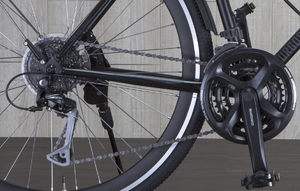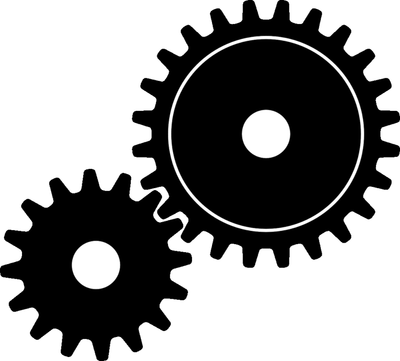Gear
Contents
Key Stage 2
Meaning
Gears are circular disks with 'teeth' that lock together with other gears to change how quickly they spin.
About Gears
- Gears are used in bikes, cars, and any engine which turns.
| The speed can be made bigger by turning the larger gear. The small gear will turn more quickly. |
Key Stage 3
Meaning
Gears are circular disks with 'teeth' that can act to increase the speed or the moment of a force.
About Gears
- A small gear turning a large gear acts to decrease the speed and increase the moment.
- A large gear turning a small gear acts to increase the speed and decrease the moment.
Key Stage 4
Meaning
Gears are circular disks with 'teeth' that can act to increase the speed or the moment of a force.
About Gears
- The multiplying effect of gears can be found by the ratio of the radii or the number of 'teeth'.
- A gear with few teeth turning a gear with many teeth acts to decrease the speed and increase the moment.
- A gear with many teeth turning a gear few teeth acts to increase the speed and decrease the moment.
- The force on one gear is equal in magnitude to the force applied to the other gear.
Example Calculations
| A gear with radius 50mm is turned with a moment of 10Nm. This gear used to turn a second gear with a radius of 20mm. Calculate the moment of the second gear. | A gear with 45 teeth is turned with a moment of 25Nm. This gear used to turn a second gear with a 63 teeth. Calculate the moment of the second gear. | A gear with 144 teeth is turned with a moment of 72Nm. This gear used to turn a second gear with 60 teeth. Calculate the moment of the second gear. |
| 1. State the known quantities
Moment = 10N Radius 1 = 50mm = 0.05m Radius 2 = 20mm = 0.02m |
1. State the known quantities
Moment = 25Nm Teeth Ratio = 45:63 |
1. State the known quantities
Moment = 70Nm Teeth Ratio = 144:60 |
| 2. Substitute the numbers into the equation and solve.
\(M = Fd\) \( 10 = F \times 0.05\) \( F = 200N\) An equal force applies to the second gear. \( M = F \times d\) \( M = 200 \times 0.02\) \( M = 4Nm\) |
2. Substitute the numbers into the equation and solve.
\( M = \frac {25}{45} \times 63\) \( M = 35Nm\) |
2. Substitute the numbers into the equation and solve.
\( M = \frac {72}{144} \times 60\) \( M = 30Nm\) |
References
AQA
- Gears, page 133, GCSE Physics, Hodder, AQA
- Gears, page 167, GCSE Physics; The Complete 9-1 Course for AQA, CGP, AQA
- Gears, page 171, GCSE Physics; Student Book, Collins, AQA
- Gears, page 57, GCSE Physics; The Revision Guide, CGP, AQA
- Gears, pages 122-123, GCSE Physics; Third Edition, Oxford University Press, AQA
Edexcel
- Gears, page 137, GCSE Physics, Pearson Edexcel
- Gears, page 213, GCSE Physics, CGP, Edexcel
- Gears, page 69, GCSE Physics; The Revision Guide, CGP, Edexcel

